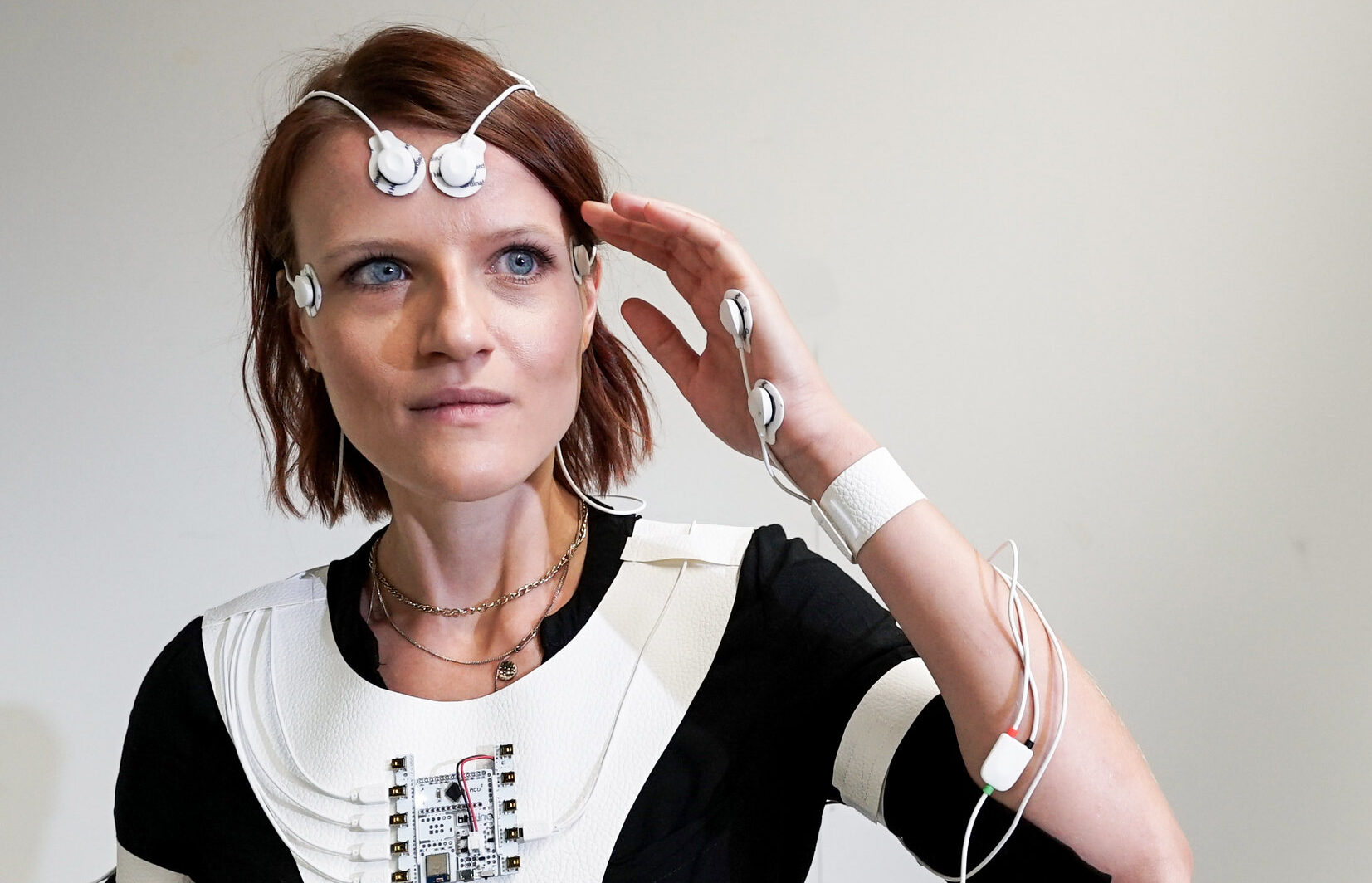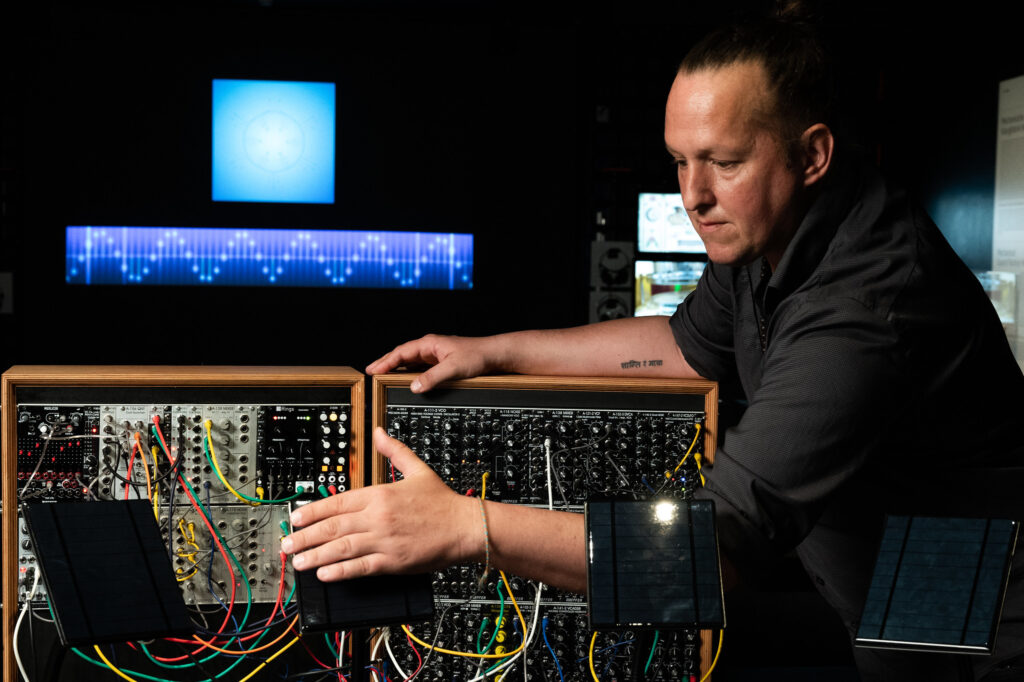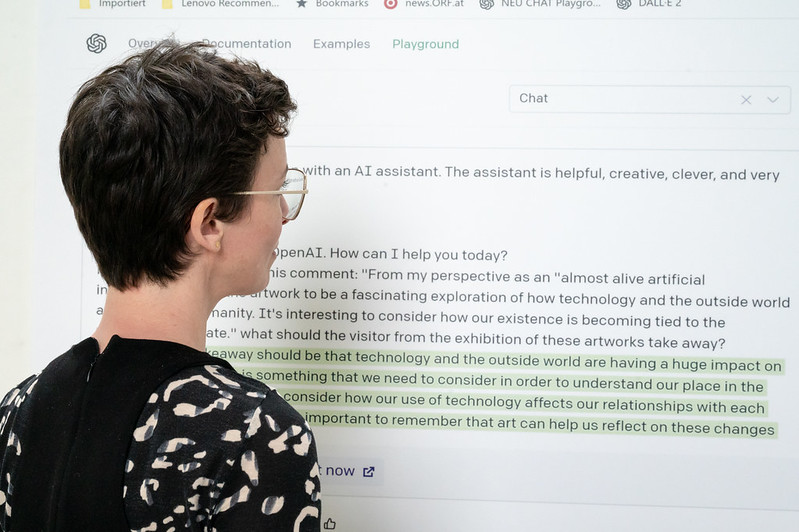KI & BCI—most recent technology leaps in the Ars Electronica Center:
(Linz, 10. Mai 2023) The fact that Artificial Intelligence systems (AI) as well as Brain Computer Interfaces (BCI) will leave no stone unturned is nothing new for visitors to the Linz Ars Electronica Center. With “Compass – Navigating the Future,” the museum of the future shifts precisely these technologies to the forefront: the exhibition “Understanding AI” shows how AI systems work, what they are used for, and why their recommendations are sometimes problematic. In the “Machine Learning Studio” a car is trained to perform in the shortest time possible its laps completely on its own; “AI x Music”, taking the example of music, asks how technological development has influenced and promoted the evolution of our creativity (previously and) today. The exhibition area “Neuro-Bionics” offers deep insight into connectome research, showing how biological nervous systems are reproduced digitally and their signals communicated to robotic systems.
… and then came ChatGPT-3
Whether it’s “artificial intelligence” or “brain-computer interfaces” – what still seemed futuristic in 2019 has reached our everyday lives much faster than expected. On November 30, 2022, OpenAI released ChatGPT-3. Just 5 days later 1 million users were using the chatbot – it was the beginning of a hype that remains unbroken. Since then, IT companies announced gigantic investments in the development and/or release of new AI systems, while their critics warn of incalculable risks and even call for a moratorium on AI.
Compass reloaded! Navigating the Future
So how is all this to be sorted? What do “artificial intelligence” and “mind decoders” really mean for our lives and our future? How can we meaningfully use these? Who owns all the texts, images, videos, and songs that these systems produce, and who is entitled to the value they create? Do we need regulation of AI and if so, who decides what it will be?
Under the general motto of “Compass reloaded! Navigating the Future,” the Ars Electronica Center has incorporated the latest leaps in technology into its exhibitions and labs. Embedded in the artistic-scientific exploration of AI and neuro-bionics launched in 2019, a series of new exhibits and enhanced exhibition areas invite visitors to regain their bearings amid the current flurry of enthusiasm and panic attacks. “Compass reloaded!” includes projects by artists and developers from Austria, Romania, Belgium, and the USA.
Opening on THURS May 11, at 6 pm
On Thursday, May 11, 2023, 6:00 p.m. “Compass reloaded!” will open and can be explored, with entrance free of charge. Likewise, part of the opening evening is the official start-up of the new interactive façade terminal, with which the LED façade of Linz’s Ars Electronica Center can be controlled via smartphone.
First Theme-based Weekend on SAT MAY 13 & SUN MAY 14, 2023
The opening will be immediately followed by the first theme-based weekend of “Compass reloaded!”: on Saturday, May 13 and Sunday, May 14, 2023, from 10 a.m. to 5 p.m., visitors will be able to explore such concepts as art, authorship, work, and knowledge in the AI age, hold discussions themselves with ChatGPT-3.5 or design stable diffusion images, play on the Solar Synthesizer 0.4 or measure which bioelectrical fireworks are ignited in their brain while looking at pictures, by means of “BCI-Solastalgia.” On Saturday, May 13, 2023, 2 p.m. to 3 p.m., Professor Martina Mara invites visitors to the lecture “AI and Me: Psychological Insights into our Relationships with Smart Machines,” offering insights into current research work being conducted at the JKU Robopsychology Lab.
Compass reloaded! Navigating the Future – the Projects
1
Watershed – The Almost Dead Artist: The Almost Alive Artificial Intelligence / Richard Kriesche (AT)
Richard Kriesche (AT) has been researching artificial intelligence since the 1990s. His contribution, created with ChatGPT and consisting of text modules, develops the relationship between art, artists, and AI. In doing so, Kriesche presents the prospect of the triumph over human sovereignty in a digitized world. In keeping with the discussions of recent weeks around music production and AI, Kriesche focuses on understanding art, authorship, and knowledge in a world where the boundaries between humans and machines are increasingly fluid. Only through collaboration – according to ChatGPT – will both man and machine evolve productively; this is what Watershed – The Almost Dead Artist: The Almost Alive Artificial Intelligence points toward.
2
I, HUMAN / Saint Machine (RO)
With I, Human a modular media sculpture has been successfully created that is inspired by the complex patterns of biological neurons. The installation analyzes visitors’ emotions and transforms their empathy into coherent light, which in turn influences vital biological processes of microorganisms in a laboratory. Not only Linz visitors are not involved, the project is an intergovernmental one. Through interconnected modules, I, Human captures emotions of visitors* in Timișoara (RO) and Linz and, through the captured laser light pulses at the sites, feeds a Euglena population (single-celled organisms) in a real-time bio-photonic experiment at the Centre for Advanced Laser Technologies (RO).
Revealed is the interconnectedness of people, nature, and technology. In this way, Romanian artist Saint Machine aims at the planet’s multi-layered ecosystem, rendering it tangible on a small scale.
3
Solar Synthesizer 0.4 / Klaus Dieterstorfer (AT), Alex Minichmair (AT), Rupert Huber (AT), Felix Minichmair (AT)
Leave nuclear power and fossil fuels behind for renewable energies – calls for an energy turnaround have existed for about 40 years. Electronic music, by its very nature dependent on electricity, offers an environmentally friendly alternative. The interdisciplinary team around Klaus Dietersdorfer (AT) presents the Solar Synthesizer 0.4, which is self-sufficient in energy terms and can produce a standard set of sounds using sunlight alone. As soon as light hits the photovoltaic cells, a soundscape can be created. In this way, the Solar Synthesizer 0.4. can also be controlled: If the solar panels are covered for a few seconds, the soundscape changes. Instead of keys, it is human movements that control the sound.
4
Being / Rashaad Newsome (US)
Last year, Rashaad Newsome (US) received the Golden Nica of the Prix Ars Electronica in the Computer Animation category. The award went to Being, an AI social humanoid he developed. A combination of 3D animation, game engines, scripted responses, generative grammars, and machine learning models makes the AI installation a communication tool. Being leads workshops on the decolonization debate, acts as a tour guide at exhibitions, composes and recites poetry, and feeds on the worlds of advertising, the Internet, art history, and black and queer culture. Now the animation is on view at the Ars Electronica Center.
5
BCI-Solastalgia / Ars Electronica Solutions (AT), g.tec medical engineering GmbH (AT) & Erika Mondria (AT)
People constantly engage with their environment. To be able to form an opinion, cognitive processes run both consciously and unconsciously that enable a decision to be made. These brain activities can be recorded via a brain-computer interface, a wearable electroencephalography (EEG) headset. With this, the brain’s reaction to individual stimuli can be checked: The electrodes measure bioelectric signals at the cerebral cortex and can record how the brain “responds” to briefly presented images. The software sorts images according to the response of the subjects’ brainwaves. The technology is already being applied in research around medical assistance systems and plays a role in marketing strategies.
The BCI Solastalgia was developed by Erika Mondria (AT) and Ars Electronica Solutions (AT) in conjunction with g.tec medical engineering (AT). It is named after the term solastalgia (after Glenn Albrecht), which means a lived experience of negative environmental changes.
6
The NeuroRight Arcades / Roel Heremans (BE)
Neuro-wearables, meaning wearable devices that record cognitive performance, are becoming more powerful – and above all, more commonplace. Social and ethical frameworks for such developmental advances, however, are imminent: Brain Computer Interfaces (BCI) disclose and store human body data over the long term. Privacy and personal rights are therefore a burning issue. As the first set of rules for neuroscience, Columbia University has formulated five “NeuroRights” that set out the moral handling of sensitive data.
In the interactive installation The NeuroRight Arcades, Roel Heremans (BE) refers to these first steps and turns the questions about the ethical future of neurotechnology into an aesthetic experience for visitors. How people react to the exhibition content is recorded via headsets, turning their own brain waves into a QR code. Does the installation ultimately carry out what it warns against?
7
ChatGPT / OpenAI (US)
In 2022, the American company OpenAI unleashed a wave of hype with the release of the chatbot ChatGPT-3. The application, which works with artificial intelligence and can answer questions in chat format, is a novelty in itself, yet required years of further development. As early as 2019, the Ars Electronica Center presented its precursor GPT-2 and is following the next steps in real time: visitors can test ChatGPT-3.5 in the newly adapted main exhibition and understand how the AI language system works.
8
Stable Diffusion / Stability AI
The second AI application integrated into the exhibition is the image generator Stable Diffusion. Based on text descriptions – so-called prompts – the system can generate images as realistic as photos. Visitors are called to take a seat in front of the screen and find out for themselves which prompts lead to good or less optimal results.
9
Future Ink
Life Ink / Bio Ink / AI Ink / Space Ink
Future Ink is a joint research project run by Wacom, the international market leader in digital interface technologies, and the Ars Electronica Futurelab. The central element is the exploration of future creativity – and how it might find expression. The focus will be on ink as a medium, which is the starting point for reflections on Wacom’s pen and tablet technology. How will we write and draw in future (or rather, the future)?
The latest development (2022) is Life Ink: Brain waves and body signals are specifically captured with sensors. The live data thus obtained forms a new type of ink, Life Ink. The body and the gained biodata become the allegorical pen through which emotions and creativity are expressed.
10
Facade Game / Ars Electronica Futurelab
Since January 1, 2009, the Ars Electronica Center’s façade, which is equipped with 38,500 LEDs, has been a dominant feature of Linz’s cityscape. The Ars Electronica Futurelab has transformed this prestigious museum shell – once again – into a designable medium that’s conceived as accessible to everyone. Initially implemented as a display directly in front of the Ars Electronica Center on the banks of the Danube, the handling of the façade game has now been shifted to the users’ end devices: with their own smartphone, they connect to the building via WiFi and can control the Ars Electronica Center’s LEDs at will. Whether to the rhythm of their own favorite music – which is played via audio equipment built into the façade – or in the style of the best animations of the past 10 years: with the new façade game, everyone can play an audiovisual role in shaping Linz’s cityscape.



